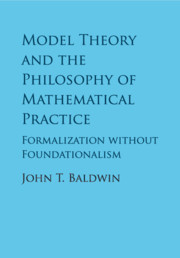Book contents
- Frontmatter
- Dedication
- Contents
- List of Figures
- Acknowledgments
- Introduction
- PART I REFINING THE NOTION OF CATEGORICITY
- PART II THE PARADIGM SHIFT
- 4 What Was Model Theory About?
- 5 What Is Contemporary Model Theory About?
- 6 Isolating Tame Mathematics
- 7 Infinitary Logic
- 8 Model Theory and Set Theory
- PART III GEOMETRY
- PART IV METHODOLOGY
- References
- Index
5 - What Is Contemporary Model Theory About?
from PART II - THE PARADIGM SHIFT
Published online by Cambridge University Press: 19 January 2018
- Frontmatter
- Dedication
- Contents
- List of Figures
- Acknowledgments
- Introduction
- PART I REFINING THE NOTION OF CATEGORICITY
- PART II THE PARADIGM SHIFT
- 4 What Was Model Theory About?
- 5 What Is Contemporary Model Theory About?
- 6 Isolating Tame Mathematics
- 7 Infinitary Logic
- 8 Model Theory and Set Theory
- PART III GEOMETRY
- PART IV METHODOLOGY
- References
- Index
Summary
On page 12, we transcribed Maddy's Second Philosopher's questions about the role of set theory to questions about model theory – What sort of activity is model theory? How does model theoretic language function? What are models and how do we come to know about them? We see in this chapter that as the paradigm changes there is increasing emphasis on the study of theories and the role of types1 as tools in assigning invariants to models and eventually these developments lead to an entanglement with classical mathematics.
As background for the key concepts of the stability hierarchy in Chapter 5.3, we start with another founding paper of modern model theory, Vaught's ‘Denumerable models of complete theories’ [Vaught 1961], delivered inWarsaw in 1959.
Analogy to Theorem toMethod
MacLane ([MacLane 1986], 37) describes analogy as ‘finding a common structure … underlying different but similar phenomena.’ In his example the concept of vector space is the common notion underlying geometry, linear equations, and linear differential equations. A main line of this book is the discovery of ‘well-defined notion of dimension’ as the common structure underlying a flock of mathematical areas. The result is not merely analogy as inspiration but analogy manifested as actual mathematical theorems. A fundamental tool for this work is itself a product of an analogy turned into a theorem and then into a model theoretic method. As Schlimm [Schlimm 1985] explains, successive analogies of propositional logic with algebra by Boole, of Boolean algebras with rings by Stone, and of deductive systems with Boolean algebra by Tarski led to a remarkable unification of topology and logic.2 Even more remarkable is that Tarski's topological description of syntactic objects was transformed in the 1950s into a powerful method for studying semantics. First, we explore the Boole–Stone– Tarski axis; then we pass to the more modern incarnation in model theory.
Theorem 5.1.1There is a functorial 1–1 correspondence between Boolean algebras and totally disconnected Hausdorff spaces.
The exact nature of this correspondence is crucial. To describe it we introduce the notion of the Stone space of a Boolean algebra and relate it to logic. Consider propositional logic with a set V of k propositional variables.
- Type
- Chapter
- Information
- Model Theory and the Philosophy of Mathematical PracticeFormalization without Foundationalism, pp. 119 - 147Publisher: Cambridge University PressPrint publication year: 2018

